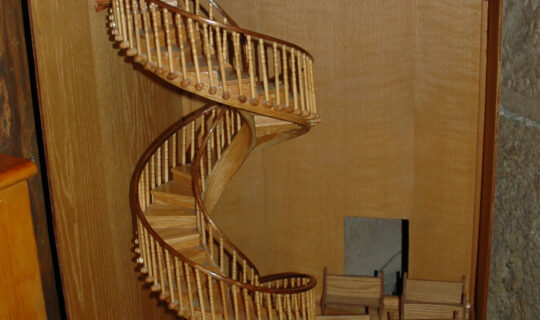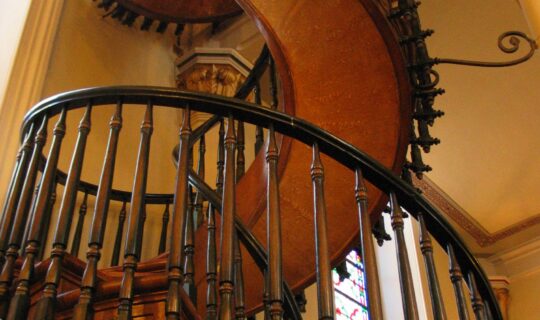A complex helical staircase with a fascinating legend behind it
The Loretto Chapel is a part of the Loretto Academy school for girls in Santa Fe, New Mexico, which was run by an order of nuns up until 1968, when the school closed and demolished, whilst the chapel became a privately owned museum and wedding venue.
The helical staircase has been nicknamed ‘Miraculous Stair’ due to its design, which features two full turns over a height of six metres without a central support, and a wooden construction which used no glue, nails or other hardware. The inner stringer is made of seven segments whilst the outer stringer has nine, and there are 33 steps in total.

Whilst the staircase might not look very miraculous by today’s standards, it was a highly innovative design for its time and perplexed builders and carpenters for many years. Bearing in mind that it was constructed before modern tools or electricity, and supposedly single-handedly by one carpenter, it’s definitely an impressive feat!
Curious Construction
The chapel was originally constructed in 1878, but did not include a way to access the choir loft 22 feet above the main space – possibly due to the death of the architect in 1879. When carpenters were initially consulted about the problem they said a ladder would need to be used due to the lack of space available, but the nuns were not satisfied with this and decided to pray to St Joseph (the patron saint of carpenters) for a solution.
According to the legend, after nine days of prayer a man arrived on a donkey with a toolbox and said that he could construct a staircase for the chapel. He worked alone for several months, using simple hand tools and never revealing his identity. Once the staircase was completed, the man disappeared without claiming any pay, despite the nuns’ efforts to track him down.

Originally the staircase lacked any sort of handrails or safety features and was apparently quite terrifying to climb and descend, so rails were added in 1887 by another craftsman, along with an iron support bracket to reduce the ‘springiness’ of the staircase – though it has been mostly closed to the public since the 1960s.
The Unknown Carpenter
The Sisters of Loretto viewed the staircase’s construction as a miracle and reportedly believed that the mysterious carpenter must have been Saint Joseph himself. The story spread over the subsequent years, turning the chapel into a popular tourist attraction.
In the 2000s, an amateur historian named Mary Jean Cook put forward a theory that the mystery builder was a reclusive rancher and carpenter named Francois-Jean Rochas who had arrived in Santa Fe from France in the 1870s. A logbook from the chapel contained an entry confirming that Rochas had been paid $150 for ‘wood’ in 1881. Added to this, an article in the Santa Fe New Mexican newspaper in 1895 describing Rocha’s murder stated that “was favorably known in Santa Fe as an expert worker in wood. He build [sic] the handsome stair-case in the Loretto chapel and at St. Vincent sanitarium.“ seemingly confirming this theory.